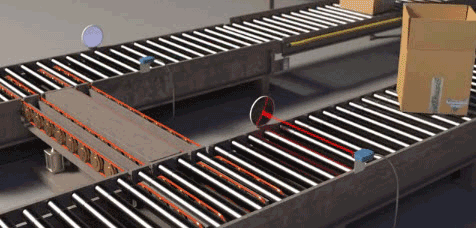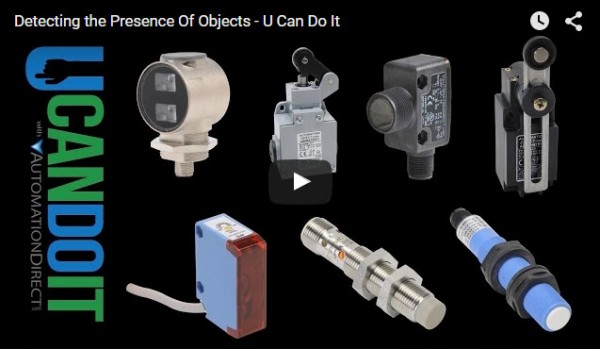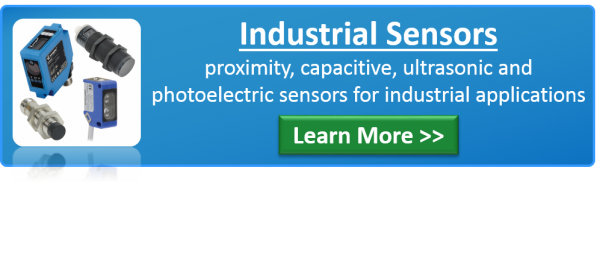A common function of a control system is detecting the presence of an object. Whether you are detecting the presence of an object passing by on a conveyor, the closure of a gate or the position of a machine part as it goes through its motions, object detection is a staple of the automation industry. There are many object sensing technologies, such as mechanical; inductive, capacitive and ultrasonic devices that detect nearness (proximity); and photoelectric sensing using light beams.
Limit Switches
The most basic sensor is a limit switch, an electromechanical device used to detect the presence or absence of an object. The switch operates its set of contacts when its actuator comes into physical contact with the sensed object. Actuator styles offer application – specific means of contact – rollers, levers, springs, wands, plungers, etc. However, since they consist of moving parts, they are prone to wear and damage, and making physical contact with the sensed object is not always desirable or possible.

Limit Switch: plunger in action
Inductive Proximity Switches
Inductive proximity switches are the most common and inexpensive non-contact sensing technology, used to detect the presence of metallic objects without actually touching it. Their high-speed switching and small size make them indispensable in automation applications. Some typical inductive sensor applications are counting metallic objects, monitoring the position of elements in a machine, sensing the presence of metallic parts like screws, etc., and measuring rotational speed.
Capacitive Sensors
Capacitive sensors detect objects with a dielectric constant different from air, which makes them ideal for a much wider range of material detection, such as wood, liquids and plastic. Their operation is similar to inductive sensors, but instead creating an electrostatic field (vs. electromagnetic) that is changed by the presence of the object.
Ultrasonic Proximity
Ultrasonic proximity sensors are based on the emission of a sound impulse and detecting the return echo signal reflected by the object. The ultrasonic beam is well reflected by almost all materials (metal, wood, plastic, glass, liquid, etc.) and is not affected by colored, transparent, or shiny objects.
Photoelectric Sensors
Photoelectric sensors use a variety of sensing technologies that address diverse application configurations, all using light beams as the detecting medium. The three most popular are diffuse, reflective and through-beam styles. The light source used – visible, infrared, LED, laser – will affect the sensing distance.
Diffuse Sensors
In diffuse sensors, the emitter and receiver form part of the same unit. The optical beams are either parallel or slightly converging. The presence of an object in the optical field causes diffused reflection of the beam. The receiver detects the reflection from the object itself.
Reflective Sensor

A reflective sensor also houses the emitter and receiver in the same unit, with the optical beams being parallel. The emitter’s luminous beam hits a reflector mounted on the opposite side of the object’s travel path and is redirected toward the receiver. Detection occurs when the path of the beam is interrupted by the presence of an opaque object.
Through-Beam Sensors
With through-beam sensors, the emitter and receiver are housed in two separate units and are installed in line with each other on either side of the object path. Detection occurs when the beam is interrupted by the presence of an opaque object. This style is the most accurate, with the farthest sensing ranges, up to 30 meters, and 50 meters or longer when using laser sensors.
But how do you know which technology to use? How do you know what to watch out for to avoid the common mistakes? Where do you go to see demos of how to configure the sensors, how to wire them, and how to program them into a PLC?
Easy! You can check out the Object Detection chapter in our Automation VIDEO Cookbook. Learn about each type of sensing technology and its suitable application spaces.
“Tech Tip” videos start with an overview of the various kinds of object detection technologies and provide some insight into the cost vs. performance info you need to know. Then we break down each technology, explaining how to use it, what mounting options are available, things to watch out for, and when it’s appropriate to use each.
The “How To” videos show step-by-step how to wire and use programming logic with the various types of object detection sensors, connecting to CLICK, Do-more or Productivity series PLCs, including examples of how to wire both NPN and PNP sensors.
To read more articles about programmable control, click here.



